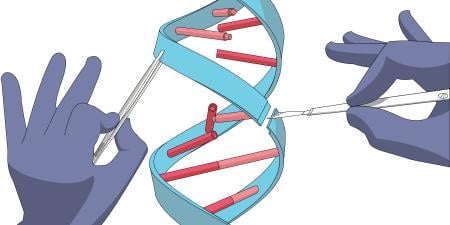Abstract
Efforts to conceptualize the application of human genomics to health care have displayed an evolving set of translational research goals. Under personalized genomic medicine, the aim was to individualize treatment and empower patients to take more responsibility for their own health. With the rise of interest in expert interpretation of multifactorial risk stratification, emphasis shifted to giving clinicians better tools and more authority to use them under the rubric of precision medicine. The statistical nature of risk stratification, in turn, led to the movement’s importing public health goals and expanding its scope to precision prevention at the population level. Today, the confluence of precision medicine and precision prevention in precision health is leading to wellness genomics aimed at achieving goals beyond health care entirely. Each of these reorientations suggests important ethical questions for the medical community.
Introduction
A century ago, American medical intellectuals and public health pioneers were galvanized by the prospect that newly deciphered laws of heredity would revolutionize their efforts to improve the population’s health. They called their approach eugenics. Fifty years later, eugenics had come to signify scientific racism, coercive reproductive policies, and the politicization of medicine. Both its goals of “preserving the germ-plasm” from the degradations of miscegenation, immigration, and feeble-mindedness and its methods for “breeding better humans” were repudiated as bad science and worse medicine.1 Instead, the scientific literature of the 1960s was full of enthusiasm for the new biology inspired by the recently deciphered molecular genetic code, and technophilic physicians looked forward to the dawn of a genetic medicine that could use “genetic engineering” to do for stubborn constitutional conditions what germ theory and antibiotics had done for infectious disease.2 For these physicians and scientists, the hope was that techniques for cutting and splicing DNA molecules would allow genetic diseases like sickle cell anemia to be reinterpreted as “molecular diseases” and that new “gene therapies” could be devised to tackle them at the molecular level.3
But even as the first human gene transfer trials got underway to mark that dawn in 1990, it was clear that a genetic medicine aimed at compensating for rare Mendelian disorders like sickle cell anemia would only address a tiny fraction of the population’s health problems. Instead, the attention of the molecular biology community turned to the promise of mapping and sequencing the whole human genome to provide a new paradigm for health care in general, based on a finer-grained understanding of individual genetic variation.4 Its promoters and architects dubbed this vision personalized medicine and predicted that it would set the course for medical progress into the future by allowing physicians to tailor pharmaceutical interventions and lifestyle prescriptions to each patient’s unique genomic profile and thereby empower patients to take more responsibility for their own health.
But as the rush to market personalized medicine directly to consumers underscored, the promises of “personalization” also came with caveats for clinicians suddenly faced with patients wielding uncertain and limited information about their genomic profiles. As a result, by 2013, the luster of personalized medicine was waning for the genomics research community that had promoted it.5 The label that leaders of the genomics community rapidly switched to in the titles of articles, conferences, and institutional programs was precision medicine, both because it reemphasized the need for professional judgment and because it opened up the prospect of taking genetic risk stratification beyond the individual patient to the population level. Subsequently, with the emergence of precision public health and precision prevention aimed at using genomic and environmental data to address population-level health disparities, many began extending the reach of human genomics beyond patient-based clinical medicine into public health and health promotion contexts under the label of precision health. Furthermore, today in the commercial sector we see services promoted under the banner of wellness genomics to indicate an interest in using genomic data to improve our understanding of perfectly normal human traits with the goal of enhancing our lives beyond managing health risks.
As labels for particular visions of what the science of human genetics and genomics might contribute to human welfare, the use of the terms “eugenics,” “genetic medicine,” “personalized medicine,” “precision medicine,” “precision health,” and “wellness genomics” reflects the progression of a long conversation between basic scientists, physicians, and the larger society. Each successive term represents an effort at ethical and scientific course correction in response to the pitfalls of the preceding model. Although applied human genomics entails a very different set of social practices than applied human genetics under eugenics, each vision has been celebrated in its day by both science and medicine as the wave of the future, and all share a common commitment to scientific meliorism—ie, the conviction that the primary goal of human genetic research is to promote human welfare.6
A century from now, will precision health and wellness genomics be used as eugenics is today, to label ideas and programs that critics find morally wrongheaded and socially dangerous? It depends entirely on how these labels are interpreted and applied by the rising generation of physicians and public health planners. We do not yet know how things will go, but we can pick up some clues to possible directions through the connotations of the very names themselves. Like most labels, all the names that have been coined for the practice of applying genetic knowledge to human problems connote tacit values, goals, and assumptions that shape how their proponents think and act.
In this essay, we illustrate this thesis by reviewing three critical rebranding episodes in contemporary genomics: the recent transition from personalized to precision medicine, the ongoing transition from precision medicine to precision health, and the incipient transition from precision health to wellness genomics. Just as genetic medicine reclaimed applied human genetics from the ideological biases of eugenics by giving it traditional medical goals and personalized medicine marked a moral emphasis on individual patients’ responsibilities, so each of these shifts within genomics highlights a different set of ethical commitments that will be important to monitor as the field matures.
From Personalized to Precision Medicine
To distinguish the anticipated health benefits of genomic research by a term that was remote from both the historical shadow of eugenics and the relatively mechanical metaphors of genetic engineering, a wide range of translational genomic researchers, medical institutions, and commercial entities turned to personalized genomic medicine to describe their translational goal in the first decade of the 21st century. As the name suggests, the idea was that genomic profiling would empower individuals to take more control over—and responsibility for—their health by clinicians’ provision of individually tailored genetic health risk assessments that they could use to guide treatment, prevention, and lifestyle choices.7
Unfortunately, neither the methods of genetic research nor the realities of clinical genomics fit very well with this laudably patient-centered vision. First, genomic science could not individualize prescriptions because the health risks associated with individuals’ genetic variants are always population-level risks based on stratifying patients into different statistical subgroups. Furthermore, the amount and complexity of statistical information that genome-wide screening and sequencing generate makes it difficult for individual patients to assimilate and interpret, which risked simply encouraging patient confusion rather than empowering more responsible health-related decisions. As a result, critics argued that the rhetoric of personalized medicine overpromised the potential of genomic information to provide individualized health recommendations that clinicians and patients could meaningfully use to manage health outcomes.8,9 In the face of widespread exploitation of the language of individual empowerment by commercial genetic testing companies,10 scholars defended the role of professional judgment as an argument for keeping genomics within the purview of the clinic as opposed to abdicating it to direct-to-consumer applications.5
As a result of these challenges, almost immediately after personalized medicine was declared a “revolution” in medical thinking,7 the application of genomics to medicine was reconceived by the leaders of the genome research community as a feature of a new movement called precision medicine.11 Discussing the National Research Council report that introduced the new label, genome scientist Maynard Olson wrote, “I think ‘personalized medicine’ was perhaps a useful rubric with which to launch this activity, but it sends a misleading message—actually both to ourselves and the broader community.”12 Precision medicine was intended to contextualize genetic health risks by integrating large amounts of data from multiple sources to identify causal factors that might influence health. Interpreting this information sensibly requires even more professional involvement than an individual genomic scan, making claims to patient empowerment even more hollow in this context. Indeed, “precision” carries very different connotations than “personalization” as to whom this approach is intended to empower, since in common parlance precision equipment is designed to be used by experts, not amateurs. If precision medicine primarily provides tools for physicians, it is clear that clinicians should bear more responsibility for making decisions about their use. This shift in ethical priorities was reflected in the first round of professional policymaking debates about the clinical use of genomic sequencing related to opportunistic clinical identification and disclosure of genetic risk markers without specific patient consent.13 In giving health care professionals authority to disregard or avoid soliciting patients’ preferences about identifying and disclosing their genetic risks, precision medicine seemed to be creating new social responsibilities for patients to be accountable to their health care professionals’ recommendations.9,14,15
From Precision Medicine to Precision Health
Dogging the heels of precision medicine are efforts by public health officials and health care institutions to rebrand the biomedical uses of translational genomics as a feature of precision health.16 This move is driven by precision medicine’s commitment to correlating genomic data with information about people’s lifestyles, environments, and communities and its subsequent need to shift applications from individual patients to the populations to which they belong.17 Of course, health sciences—such as epidemiology, environmental health science, and health behavior—elucidate extra-genetic health risks and have traditionally been concerned with protecting and promoting the public’s collective health rather than with individuals’ medical treatment. The movement’s incorporation of population sciences has led to the emergence of new banners—precision prevention, precision public health, and precision health—that allow this aspirational goal to translate easily between individual and population levels. By applying the tools of precision medicine to disease prevention and early identification of risk, proponents argue that “‘precision prevention’ then may be useful in using both science and limited resources for targeting prevention strategies to subsets of the population.”18
The reorientation of translational genomic research towards public health goals raises two particularly important professional ethical and social policy questions. The first is the danger of interpreting information about genetic variation across populations in ways that reinforce culturally situated or politically constructed social categories like race, ethnicity, and nationality. For example, a recent National Institutes of Health initiative seeking to use genetic variation data to address health care outcome disparities defined the “disparity populations” of interest entirely in terms of racial and ethnic categories, implying that these categories rest on underlying genetic differences between the groups.19 Not only does this definition risk reifying group identities in ways that might exacerbate social tensions, but it also risks misdirecting attention from important social determinants of health such as poverty, education, and nutrition.20 These dangers are reflected in the widespread promotion of translational genomic research as an approach to reduce health disparities between different subgroups in the population, when in fact these disparities are driven by social determinants of health.21
The second danger posed by the adoption of public health goals for translational genomics flows from the logic of prevention itself. Traditionally, early preventive interventions have been seen as the most efficient and effective forms, and the goal of public health research has been to identify interventions that allow people to avoid exposure to the causes of morbidity entirely.22 When these causes are interpreted as genetic variants, this logic has historically been understood to prescribe interventions that prevent the intergenerational transmission of “pathogenes,” just as infection control measures prevent horizontal transmission of pathogens. Although we now criticize the authoritarian practices and punitive attitudes this logic supported during the eugenics movement, the temptation to think about genetic health problems as “vertically transmitted infectious disease”23 and to attribute preventive responsibilities accordingly continues to appear irresistible to some influential health policy and bioethics scholars today.24 But how to prevent genetic health problems without recreating the authoritarian practices and punitive attitudes we still criticize in the historical eugenics movement is unclear.25
From Precision Health to Wellness Genomics?
Finally, another trend under the precision health banner has been to bring what translational genomic research learns about population-level variation back to individuals through prescriptions for health promotion and wellness beyond the management of disease risk. As goals for health applications of genomic research have turned to “wellness,” living “longer lives,” and “thriving,” the domain of applied genomics expands again, this time beyond the range of traditional health care.26-28 This expansion is fueled by rising scientific interest in identifying genetic variants associated with phenotypes at the superlative end of our species’ functional range to better understand and support human biology when everything is working particularly well. These beneficial genetic variants include those linked to unusual resistance to disease,29 alleles associated with above-average longevity and good health,30 and genetic predictors of high levels of physical and cognitive performance.31
In animal research settings, gene editing technologies are being used to actively enhance desirable traits,32 which means that medicine and society might soon face an interesting conundrum: once we discover which variants are not just “benign” but associated with especially high levels of functioning, why not extend the use of human gene editing beyond the preventive goal of reducing the incidence of problematic variants to offer individuals opportunities for genomic optimization, even if they go beyond what is typical for our species?33 From one perspective, taking people beyond the normal range of functionality seems like the very definition of genetic enhancement, which science policy bodies like the National Academies of Sciences, Engineering, and Medicine (NASEM) continue to eschew as a morally problematic use of human gene editing techniques.34 On the other hand, enabling individuals to acquire resistance, for instance, against HIV infection through CCR5 gene editing seems very much like the moral equivalent of developing an HIV vaccine. If, like the NASEM, we include strengthening the body to resist disease as a medically appropriate form of prevention,34 then any gene editing research aimed at inserting variants associated with phenotypes at the desirable extreme of health-related functioning—such as superlative immune response, outlier tissue regeneration capacities, or world-class tolerance for environmental toxins—might be legitimized if those variants were understood to be more protective against disease than their normal versions. In fact, might not human gene editing aimed at inducing unusually acute sensory abilities, cognitive capacities, prolongevity, and exceptional strength and endurance also be counted as “strengthening human capacities to resist disease,”34 as long as these phenotypes can be shown to have preventive potential?35
The marketplace is already populated by the scores of wellness genomics labs that currently offer commercial testing for putative beneficial genetic variants—from exceptional HIV resistance36 to athletic talent37,38—and their financial future is said to be bright.39 As bona fide precision health research provides more reliable genomic predictors of exceptional capacities, the philosophical gray zone between prevention and enhancement that they will accentuate in current policy thinking about the limits of gene editing will be increasingly important to understand and address. If the paternalistic emphasis of precision medicine, the essentialism of precision prevention, and the perfectionism of wellness genomics go unnoticed and unchecked, precision health risks becoming merely another step on the road towards a new eugenomics that society could come to regret.
References
-
Bashford A, Levine P, eds. The Oxford Handbook of the History of Eugenics. New York, NY: Oxford University Press; 2018.
- Hotchkiss RD. Portents for a genetic engineering. J Hered. 1965;56(5):197-202.
-
Juengst E. Concepts of disease after the human genome project. In: Caplan A, McCartney J, Sisti D, eds. Health, Disease and Illness: Concepts in Medicine. Washington, DC: Georgetown University Press; 2004:243-263.
- Baird PA. Genetics and health care: a paradigm shift. Perspect Biol Med. 1990;33(2):203-213.
- McGuire AL, McCullough LB, Evans JP. The indispensable role of professional judgment in genomic medicine. JAMA. 2013;309(14):1465-1466.
-
Comfort N. The Science of Human Perfection: How Genes Became the Heart of American Medicine. New Haven, CT: Yale University Press; 2012.
-
Collins FS. The Language of Life: DNA and the Revolution in Personalized Medicine. New York, NY: Harper Collins; 2010.
- Juengst ET, Flatt MA, Settersten RA Jr. Personalized genomic medicine and the rhetoric of empowerment. Hastings Cent Rep. 2012;42(5):34-40.
- Juengst E, McGowan ML, Fishman JR, Settersten RA Jr. From “personalized” to “precision” medicine: the ethical and social implications of rhetorical reform in genomic medicine. Hastings Cent Rep. 2016;46(5):21-33.
- McGowan ML, Fishman JR, Lambrix MA. Personal genomics and individual identities: motivations and moral imperatives of early users. New Genet Soc. 2010;29(3):261-290.
-
Committee on a Framework for Development of a New Taxonomy for Disease, National Research Council. Toward Precision Medicine: Building a Knowledge Network for Biomedical Research and a New Taxonomy of Disease. Washington, DC: National Academies Press; 2011.
-
Katsnelson A. Momentum grows to make “personalized” medicine more “precise.” Nat Med. 2013;19(3):249.
- Evans JP, Berg JS. Next-generation DNA sequencing, regulation, and the limits of paternalism: the next challenge. JAMA. 2011;306(21):2376-2377.
- Lázaro-Muñoz G, Conley JM, Davis AM, Van Riper M, Walker RL, Juengst ET. Looking for trouble: preventive genomic sequencing in the general population and the role of patient choice. Am J Bioeth. 2015;15(7):3-14.
-
McGowan ML, Fishman JR, Settersten RA Jr, Lambrix MA, Juengst ET. Gatekeepers or intermediaries? The role of clinicians in commercial genomic testing. PLoS One. 2014;9(9):e108484. doi:10.1371/journal.pone.0108484.
- Khoury MJ, Iademarco MF, Riley WT. Precision public health for the era of precision medicine. Am J Prev Med. 2016;50(3):398-401.
- Chatterjee N, Shi J, García-Closas M. Developing and evaluating polygenic risk prediction models for stratified disease prevention. Nat Rev Genet. 2016;17(7):392-406.
-
Khoury MJ. The success of precision medicine requires a public health perspective. Genomics and Health Impact Blog. January 29, 2015. https://blogs.cdc.gov/genomics/2015/01/29/precision-medicine/. Accessed July 11, 2018
-
National Institute on Minority Health and Health Disparities, US Department of Health and Human Services. NIMHD transdisciplinary collaborative centers for health disparities research focused on precision medicine (U54). http://grants.nih.gov/grants/guide/rfa-files/RFA-MD-15-013.html. Published May 20, 2015. Accessed July 26, 2018.
- Sankar P, Cho MK, Condit CM, et al. Genetic research and health disparities. JAMA. 2004;291(24):2985-2989.
- Meagher KM, McGowan ML, Settersten RA Jr. Fishman JR, Juengst ET. Precisely where are we going? Charting the new terrain of precision prevention. Annu Rev Genomics Hum Genet. 2017;18(1):369-387.
-
Faust H, Menzel P. Prevention vs. Treatment: What is the Right Balance? New York, NY: Oxford University Press; 2011.
-
Battin MP, Francis LP, Jacobsen JA, Smith CB. The Patient as Victim and Vector: Ethics and Infectious Disease. New York, NY: Oxford University Press; 2009.
-
Buchanan A, Brock D, Daniels N, Wikler D. From Chance to Choice: Genetics and Justice. New York, NY: Cambridge University Press; 2000.
- Hens K, Dondorp W, Handyside AH, et al. Dynamics and ethics of comprehensive preimplantation genetic testing: a review of the challenges. Hum Reprod Update. 2013;19(4):366-375.
-
University of Michigan. Precision health. http://precisionhealth.umich.edu. Accessed March 19, 2018.
-
Cedars-Sinai. About precision health. https://www.cedars-sinai.edu/Precision-Health/About-Precision-Health.aspx. Accessed March 19, 2018.
-
Minor L. We don’t just need precision medicine, we need precision health. Stanford Medicine. http://med.stanford.edu/school/leadership/dean/dean-minor-on-precision-health.html. Accessed March 19, 2018.
-
Resilience Project website. http://resilienceproject.com/. Accessed March 21, 2018.
- Deelen J, Beekman M, Uh HW, et al. Genome-wide association meta-analysis of human longevity identifies a novel locus conferring survival beyond 90 years of age. Hum Mol Genet. 2014;23(16):4420-4432.
- Guth LM, Roth SM. Genetic influence on athletic performance. Curr Opin Pediatr. 2013;25(6):653-658.
-
Burkard C, Lillico SG, Reid E, et al. Precision engineering for PRRSV resistance in pigs: macrophages from genome edited pigs lacking CD163 SRCR5 domain are fully resistant to both PRRSV genotypes while maintaining biological function. PLoS Pathog. 2017;13(2):e1006206. doi:10.1371/journal.ppat.1006206.
-
Comfort N. The Science of Human Perfection: How Genes Became the Heart of American Medicine. New Haven, CT: Yale University Press; 2012.
-
National Academies of Sciences, Engineering, and Medicine. Human Genome Editing: Science, Ethics, and Governance. Washington, DC: National Academies Press; 2017.
- Juengst ET. Crowd-sourcing the moral limits of human gene editing. Hastings Cent Rep. 2017;47(3):15-23.
-
Delta-32 website. http://www.delta-32.com/. Accessed March 22, 2018.
-
Atlasgene website. http://www.atlasgene.com/. Accessed March 23, 2018.
- Webborn N, Williams A, McNamee M, et al. Direct-to-consumer genetic testing for predicting sports performance and talent identification: consensus statement. Br J Sports Med. 2015;49(23):1486-1491.
-
Grand View Research. Predictive Genetic Testing and Consumer/Wellness Genomics Market by Application (Cancer, Diabetic Screening, Parkinsonism, Cardiovascular, Orthopedic and Musculoskeletal, Nutria Genetics, Skin and Metabolism Genetics), and Trend Analysis from 2018 to 2025: report summary. https://www.grandviewresearch.com/industry-analysis/predictive-genetic-testing-consumer-wellness-genomics-market. Published January 2017. Accessed March 22, 2018.



